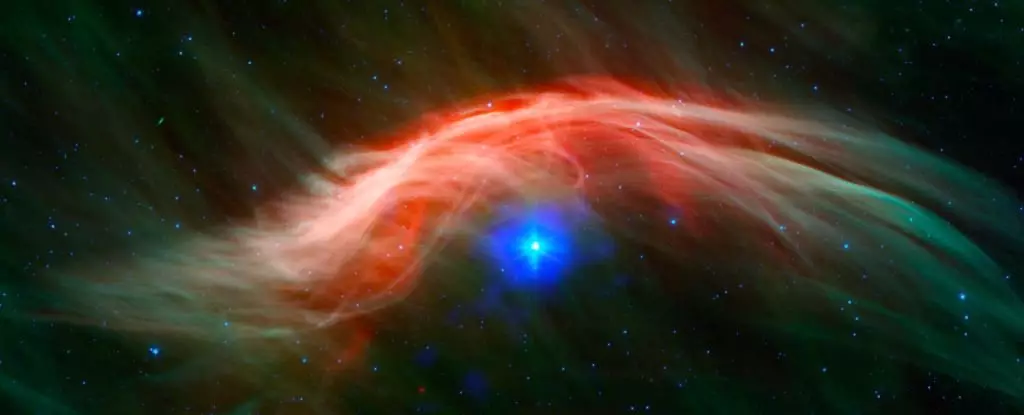In the vastness of space, extraordinary phenomena like supernovae are often thought to be distant events that have little bearing on life as we know it on Earth. However, recent research challenges this perception, suggesting a profound connection between cosmic explosions and terrestrial evolution, particularly concerning the diversity of life forms. A study led by Caitlyn Nojiri from the University of California Santa Cruz sheds light on a compelling scenario: an ancient supernova that occurred approximately 2.5 million years ago may have played a significant role in the explosion of viral diversity in Lake Tanganyika, a unique ecosystem in the highlands of eastern Africa.
The research posits that the burst of radiation emitted from the exploding star may have coincided with a dramatic increase in the diversity of viruses in the lake, suggesting a possible link between cosmic rays and biological evolution. This intriguing relationship raises essential questions about the interconnectedness of cosmic occurrences and their implications for life on Earth.
The Science Behind Cosmic Radiation and Evolution
Cosmic radiation, a complex mix of high-energy particles, has long been thought to influence evolutionary processes. While evolution is driven by various factors, including genetic mutations and environmental changes, cosmic radiation can act as a catalyst, accelerating mutation rates in living organisms. The study of Nojiri and her team considered the unique submarine geological record found in Lake Tanganyika, where sediments encapsulated the history of environmental changes over millions of years.
They focused specifically on a radioactive isotope known as iron-60, which is produced during supernova explosions. As Earth moves through cosmic environments laden with remnants from these stellar explosions, the quantity of iron-60 that deposits onto our planet can vary. Existing studies have indicated spikes in iron-60 levels in ocean sediment, prompting researchers to investigate possible correlations between these spikes and significant evolutionary milestones on Earth.
Using advanced sediment core analysis, Nojiri’s team identified two notable spikes in iron-60 deposition dating to roughly 2 to 3 million years ago. This timeframe aligns with the period of increased viral diversity observed in Lake Tanganyika. The researchers sought to trace the origin of these spikes by examining the positioning of supernova remnants and their spatial relationships to Earth.
Simulations indicated that the later spike in iron-60 corresponds with a supernova explosion likely originating from either the Scorpius-Centaurus or Tucana-Horologium star groups. Given the distances of these star clusters—460 light-years for Scorpius-Centaurus and 230 light-years for Tucana-Horologium—each offered different potential radiation exposure scenarios for Earth.
Through sophisticated modeling, the research team evaluated the potential impact of the radiation levels that would have bombarded Earth in the wake of these cosmic explosions. Initial projections suggested Earth could face additional radiation doses of up to 100 milligrays per year for an extended period following a supernova, with the possibility of DNA damage occurring from exposures over 5 milligrays annually. This further reinforces the theoretical framework establishing a link between cosmic events and biological diversity.
Although the relationship between the iron-60 spikes and viral diversification is not definitive, the overlap in timelines sparks curiosity and suggests the potential for cosmic influences to incite evolutionary changes. Nojiri pointed out that the remarkable increase in fish virus diversity in Lake Tanganyika around the same time hints at a greater narrative—an interplay of stellar phenomena and microbial life evolution.
The conclusions drawn from this study prompt a broader reflection on our understanding of life’s origins and evolutionary trajectories. The notion that cosmic events may impact life on Earth opens up an array of questions about how closely interconnected our planet is with the universe. In the grand scheme of cosmic evolution, the words of the late Carl Sagan resonate: “We are made of stardust.” This perspective encourages us to contemplate the myriad ways that the universe influences terrestrial life, both seen and unseen.
As we continue to explore the connections between cosmic events and biological realities, we may find that understanding the universe is not only a matter of astronomy but also a key to deciphering the enigmatic story of life on Earth. By recognizing the potential for cosmic phenomena to impact evolution, we can appreciate the intricate tapestry of existence that binds the universe and the planet we call home. It serves as a reminder that, regardless of their distance, all things in nature can share deep connections in this expansive cosmos.

